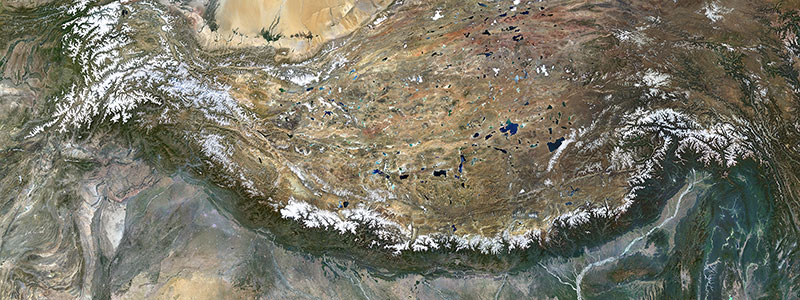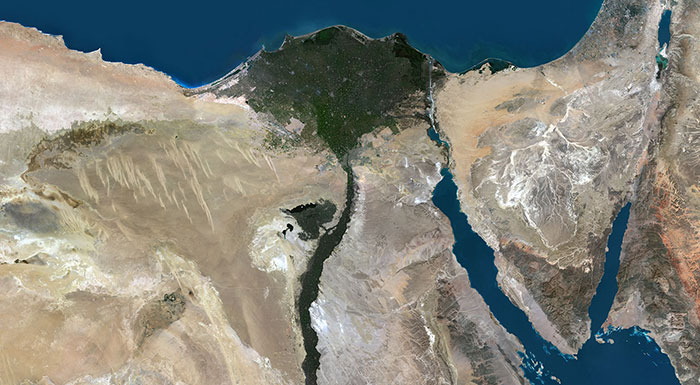Capabilities of PlanetObserver – Part 2: Satellite Image Mosaics
PlanetObserver highligts its capabilities in the Production of Satellite Image Mosaics.

The process of creating satellite image mosaics is central to our mission, involving the artful combination of thousands of satellite images to produce seamless, detailed representations of our planet. Our second article in the “PlanetObserver Capabilities” series will focus on the production of these satellite image mosaics, which is another major aspect of our service that lies at the heart of our work.
We're thrilled to bring you more insights from our experienced Technical Director, Pierre Dubus, about how the production of satellite image mosaics unfolds after the selection of the appropriate images.
For more than 30 years, PlanetObserver has specialized in producing seamless satellite image mosaics of the Earth in natural colors. With a 10-meter resolution, PlanetSAT global mosaic stands as the flagship product of PlanetObserver. It is a comprehensive, seamless, cloud-free, and natural color mosaic of satellite images from around the globe. All images are meticulously assembled to form a visual map of the world, faithfully capturing the Earth's authentic colors and landscapes.
Steps of the Production of Satellite Image Mosaics
Every year, PlanetObserver integrates the latest Sentinel-2 imagery to update its PlanetSAT Basemap with new, country-wide satellite image mosaics. But how exactly is this production process carried out?
Once the appropriate scenes have been selected, the production process for creating natural color image mosaics progresses through several key steps:
- Mosaic creation and preprocessing: The raw images are merged together to form a single, continuous mosaic, and then reprojected into the appropriate geographic projection.
- Cloud removal: For most parts of the world, optical images collected by satellites are affected by haze or clouds. To effectively eliminate clouds, the filling technique is applied. It involves replacing the cloudy pixels and areas with cloudless data from other scenes at different dates. The different scenes are then homogeneously merged. The result of this thorough process produces a clean and cloud-free image.
- Color balancing: The mosaic is then color-balanced, taking into account factors such as brightness, contrast, and color consistency, to ensure uniformity and accuracy in color representation. This involves adjusting the Red-Green-Blue (RGB) color channels to reflect true colors as closely as possible.
- Seam removal: Seams, which are visible boundaries between adjacent images, are removed to create a seamless transition between tiles in the mosaic.
- Quality control: The final mosaic undergoes thorough quality control checks to ensure accuracy, consistency, and visual appeal. Any imperfections or anomalies are identified and corrected during this stage.
- Technical specifications and metadata: Once the mosaic is finalized and approved, it is prepared in different file formats (Geotiff, COG, JPEG 2000) and resolutions (10-meter full resolution, and other down-sampled resolutions, such as 40m and 150m). The standard projection is Geographic WGS84. However, it can be adapted to fulfill specific customers’ needs. Metadata for each annual version of PlanetSAT mosaic are prepared, to provide information on the date and source of each single scene.

The majority of these steps are executed through advanced algorithms, streamlining the process. Various tools, such as Global Mapper, play a pivotal role throughout the processing stages. Global Mapper stands out as cutting-edge GIS software, offering a wide number of spatial data processing tools and granting access to a diverse range of data formats, thereby enhancing efficiency and versatility in satellite image mosaic production.
For customized mosaic production, we have the flexibility to leverage a wide range of available images from various sources in the market. This includes utilizing open-source data such as 10-meter Sentinel-2 and 15-meter Landsat 8, as well as very high-resolution commercial data from providers like Maxar and Onyx Space, ensuring we have access to the most suitable imagery for our clients' specific needs.
As we wrap up this segment, we've taken a closer look into how PlanetObserver creates top-notch satellite image mosaics. Keep an eye out for our next article, where we'll dive deeper into the world of color processing and showcase our specialized technical abilities.



